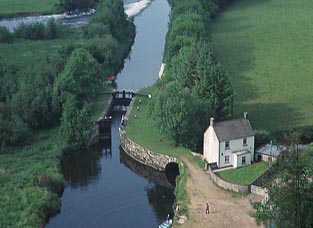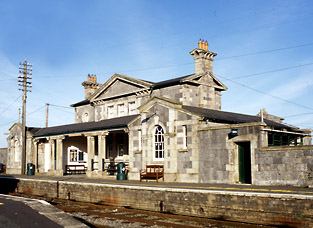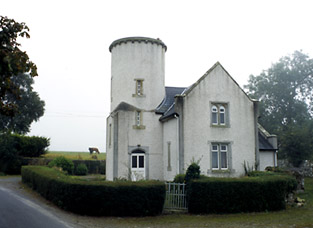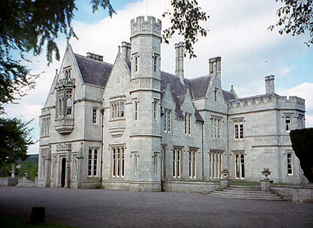Carlow


 Transportation networks were improved in County Carlow in the eighteenth century in response to increased agricultural and industrial activity in the region. The Barrow Navigation was initiated in the 1750s, canalising previously unnavigable stretchers of the River Barrow, allowing produce to be shipped in bulk to domestic markets and to harbours for export to foreign markets. Bridges, locks, lock keeper’s houses, malthouses, stores, and a plethora of canal-related structures are still evident along the course of the Barrow Navigation.
Transportation networks were improved in County Carlow in the eighteenth century in response to increased agricultural and industrial activity in the region. The Barrow Navigation was initiated in the 1750s, canalising previously unnavigable stretchers of the River Barrow, allowing produce to be shipped in bulk to domestic markets and to harbours for export to foreign markets. Bridges, locks, lock keeper’s houses, malthouses, stores, and a plethora of canal-related structures are still evident along the course of the Barrow Navigation.
 The improvement of the road network and the construction of the Great Southern and Western Railway during the nineteenth century diminished the importance of canal and river transport. The establishment of the railway had a profound effect on the landscape of County Carlow. Bridges and viaducts, railway stations and station masters’ houses, and a wide range of related structures were built at this time and some of which were executed in elaborate architectural styles: Bagenalstown Railway Station is a gem of Classical architecture while Borris Railway Station is a picturesque composition in the severe Tudor Revival style.
The improvement of the road network and the construction of the Great Southern and Western Railway during the nineteenth century diminished the importance of canal and river transport. The establishment of the railway had a profound effect on the landscape of County Carlow. Bridges and viaducts, railway stations and station masters’ houses, and a wide range of related structures were built at this time and some of which were executed in elaborate architectural styles: Bagenalstown Railway Station is a gem of Classical architecture while Borris Railway Station is a picturesque composition in the severe Tudor Revival style.
 County Carlow is dotted with a number of houses whose corners are marked by slender turrets with neo-medieval loop-like windows. Some of these curious houses were purpose-built as constabulary barracks, others as tenant farmhouses, and each one continues to make a picturesque impression in its own setting.
County Carlow is dotted with a number of houses whose corners are marked by slender turrets with neo-medieval loop-like windows. Some of these curious houses were purpose-built as constabulary barracks, others as tenant farmhouses, and each one continues to make a picturesque impression in its own setting.
 County Carlow boasts a remarkable heritage of country houses. A small number date back to the eighteenth century, the names of their architects lost in the mists of time, but the majority were built or rebuilt in the nineteenth century and gave an opportunity to celebrated architects of the day to showcase their creativity whether working in Classical or neo-medieval styles. Thomas Alfred Cobden (1794-1842), a London-born architect resident in Carlow, is credited with the elegant granite-faced Browne’s Hill but is probably best known for transforming the plain Duckett’s Grove from a Georgian farmhouse into a multi-turreted Gothic fantasy. Richard Morrison (1767-1849) similarly reworked Borris House by adding a profusion of Tudor ornaments and pinnacles while his son, William Vitruvius Morrison (1794-1838), remodelled Oak Park in the Classical style and gave it its commanding pillared portico. The prolific Daniel Robertson (d. 1849) was a favourite of the Carlow gentry and his legacy includes the Tudor Gothic Dunleckney Manor, the turreted Castletown House and the serene Upton House with its lofty porte cochère.
County Carlow boasts a remarkable heritage of country houses. A small number date back to the eighteenth century, the names of their architects lost in the mists of time, but the majority were built or rebuilt in the nineteenth century and gave an opportunity to celebrated architects of the day to showcase their creativity whether working in Classical or neo-medieval styles. Thomas Alfred Cobden (1794-1842), a London-born architect resident in Carlow, is credited with the elegant granite-faced Browne’s Hill but is probably best known for transforming the plain Duckett’s Grove from a Georgian farmhouse into a multi-turreted Gothic fantasy. Richard Morrison (1767-1849) similarly reworked Borris House by adding a profusion of Tudor ornaments and pinnacles while his son, William Vitruvius Morrison (1794-1838), remodelled Oak Park in the Classical style and gave it its commanding pillared portico. The prolific Daniel Robertson (d. 1849) was a favourite of the Carlow gentry and his legacy includes the Tudor Gothic Dunleckney Manor, the turreted Castletown House and the serene Upton House with its lofty porte cochère.